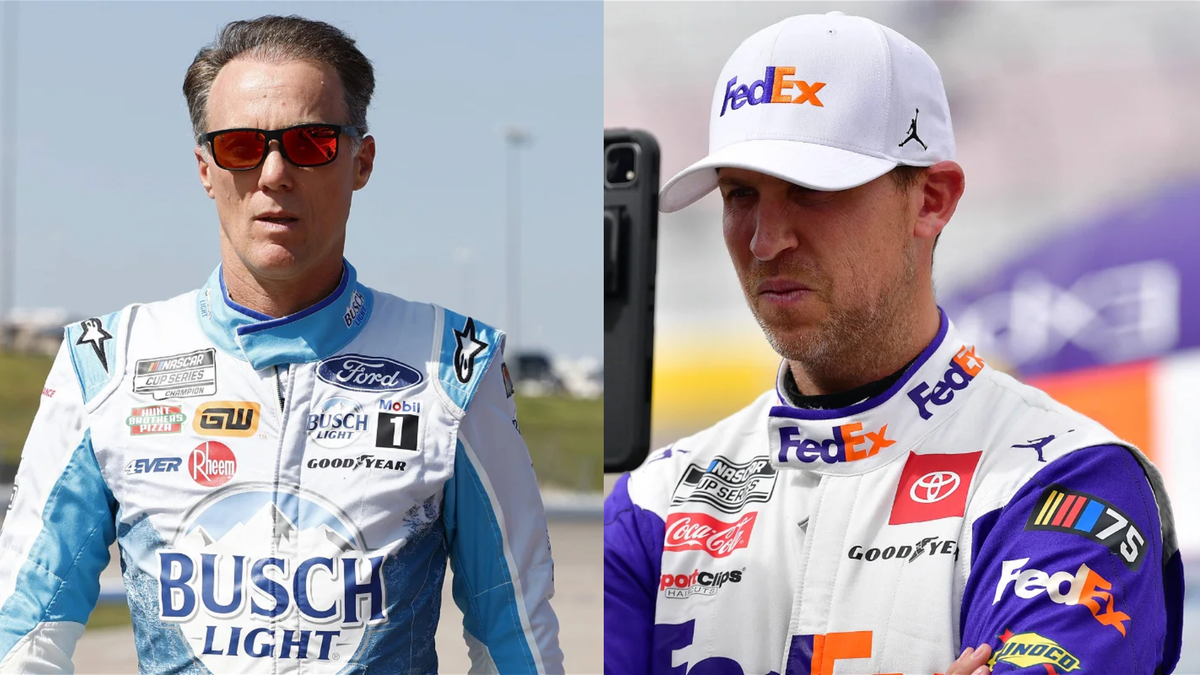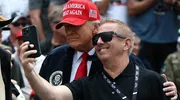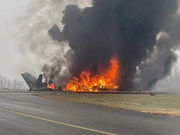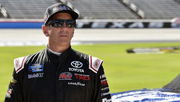
Imago
Denny Hamlin and Kevin Harvick | Credits – Imago

Imago
Denny Hamlin and Kevin Harvick | Credits – Imago
The Texas Motor Speedway was a crucible of speed and strategy, where NASCAR’s elite fought fiercely over 267 grueling laps. For Denny Hamlin, driving the No. 11 Toyota, the race was a high-wire act that ended in a terrifying inferno, leaving spectators and crew in stunned silence. At lap 75, his engine collapsed with a catastrophic failure, engulfing his car in flames between Turns 1 and 2, and sending him driving a smoke-filled cockpit to safety. It could have cost him dearly, but Hamlin’s getaway was nothing less than miraculous. He called it a “grim reality” of the sport, and Kevin Harvick, with his keen insight, peeled the layers of this fiasco, attributing it to a mechanical malfunction as well as previous strategic blunders.
Watch What’s Trending Now!
Hamlin’s race began with promise. Starting strong, he led early, holding the front by lap 24 before a costly error shifted his trajectory. A miscommunication involving the team’s “cowboy code word” led to a critical mistake during a lap 22 pit stop under caution. Hamlin intended to pit but stayed out, only to be caught speeding on the pit road when he finally came in, dropping him in the field. By lap 64, he had clawed back 10 positions, showing the No. 11’s raw speed, but the damage was done. Mamba Smith put it bluntly: “It wasn’t going to matter. It didn’t matter to them. They were still going to blow up at that point, anyway.” But what caused the fire?
ADVERTISEMENT
Kevin Harvick points to the part that might have caused the fire
The fiery climax came on lap 75, when Hamlin’s engine expired under green flag conditions, triggering a caution. Thick smoke and flames engulfed the car, a shocking sight for the Next Gen era. Hamlin recalled the terror: “You know, you try to limit the damage and just get it back so the guys have something to look at. It’s frustrating. Fans watched in horror as he remained in the car longer than seemed safe, making his escape a heart-pounding relief. Smith added, “I’m glad he was okay because I felt like he was in that car for a long time for how much smoke was coming through.”
Harvick’s analysis cut to the core: “It looks like it was a fuel fire, but sounds like they broke a valve spring, dropped a valve. And then it exploded. So it sounds like this was the third race on that particular engine, based upon the feedback that I got from Larry Mack. … Those margins of speed are getting closer together, and when those margins of speed get closer together, they wind up pushing things a little bit further. … We saw this, what I thought was a valve spring issue last year with the Toyota engines, and they blew up three or four of them in a row.” Harvick’s insight revealed a broader issue: NASCAR’s pursuit of speed pushes components to their limits.
He went deeper, warning, “When you start hearing valve spring, that to me is terrifying … that comes with bad batches and then you start having these different batches of valve springs all over the place, so sometimes it’s hard to wrangle those problems.” The race itself was a chaotic affair, with 15 lead changes among 11 drivers and 10 cautions for 65 laps. Carson Hocevar led early from the pole, followed by Austin Cindric’s dominance in Stage 1 and Kyle Larson’s Stage 2 win. By lap 99, Josh Berry surged to the lead, only to crash out on lap 125, while Hamlin’s fire on lap 75 marked one of the race’s defining moments. Michael McDowell led late under caution on lap 251, but Joey Logano ultimately crossed the finish line first on lap 267, capitalizing on a race fraught with attrition.
ADVERTISEMENT
NASCAR engineer Joey Cohen suggested oil pressure or fuel system issues as potential culprits, but the valve spring theory aligns with a pattern of failures. He had explained, “The exhaust used to run the full length of the rocker panel, so we used to exit the exhaust in front of the rear tires. What we come to find out there was those exhaust pipes under the driver were carrying a large amount of heat and just soaking that underside of the chassis, basically cooking the drivers.” Gladly, Denny Hamlin was the only driver who experienced flames from his car, and he was fine. The incident unfolding took us to the 1981 Indy 500. The entire IndyCar franchise could have suffered the loss of life or even closure if that event had ensued.
Rick Mears, the motorsport legend and Team Penske’s integral part, was on death row without a trial. How? Well, those days saw open-wheel cars use methanol as a fuel as it burned cleaner. But they had forgotten something. The substance burns with a blue flame and is only visible at night. So when a methanol fire erupted in Mears’ pit box during the race, engulfing his car and helmet, nobody understood why he was jumping around. Think about the fans! They saw Rick and some of his crew members dancing around mindlessly without understanding the gravity of the situation. But if Mears wasn’t defiant enough, he could never have been recognized as a sensation.
ADVERTISEMENT
Despite the setback, Hamlin remained defiant. His partnership with crew chief Chris Gayle keeps them in contention, but the Texas fire was a stark reminder of the sport’s dangers. For fans, it was a visceral jolt, underscoring the risks drivers face. Harvick’s commentary framed the incident as both a mechanical failure and a cautionary tale: where speed is king, disaster lurks. Hamlin’s lucky escape ensures he’ll race again, but the question lingers—how close are we to crossing the line?
Top Stories
NTSB Appeals for Greg Biffle’s Wife’s Alleged In-Flight Text Messages as Crash Investigation Heats Up

Donald Trump Issues Moving Message of Condolence for NASCAR’s Greg Biffle & Family During North Carolina Address

Another Almost Fatal Disaster Surfaces From Statesville Airport Amidst Ongoing Greg Biffle’s Crash Investigation

Air Safety Investigator Probes Possible Co-Pilot Role Amid Greg Biffle’s Fatal Plane Crash Investigation

Greg Biffle’s Haunting Aviation Admission Resurfaces Hours After Tragic NC Plane Crash

Denny Hamlin’s chaotic code-word game got him fuming
Denny Hamlin’s Texas race was a gut-wrenching disaster that left fans stunned. During the Autotrader EchoPark Automotive 400, the first round of pit stops turned into a nightmare for his No. 11 team. The code word “Cowboys” triggered total chaos on the radio, with overlapping voices sowing confusion. Hamlin, caught in the mess, sped on the pit road, missed his pit stall, and had to make a second, agonizing trip through the pit lane. NASCAR didn’t hesitate, hammering him with a penalty for speeding and improper pit entry, forcing him to the back of the field.
ADVERTISEMENT
His raw frustration crackled over the radio: “You boys were talking over each other, and I heard ‘Cowboys,’ and obviously I looked at my card.” That moment of betrayal stung, erasing weeks of preparation in seconds. Texas is brutal for passing, with “dirty air” making it nearly impossible to climb through traffic. Analysts gave Hamlin slim odds of recovering, and you could feel the weight of this blow to his championship hopes.
Kevin Harvick, meanwhile, is fed up with these shady tactics. On the podcast, he revealed his true feelings: “I hate the code words,” Harvick stated, “I know a lot of them use the code words. I feel like it’s follow the leader in some of those scenarios. I never like — we s—— the code word up one time, and I’m like, ‘We’re done with code words.’ Just tell me when to pit.” With 20 years of experience, Harvick’s plea for fairness hits hard, especially after Hamlin’s blunder.
Fans are split—some root for Hamlin’s comeback, others back Kevin Harvick’s call for a cleaner sport. Can Hamlin rally? Will Harvick’s words spark change? Let us know in the comments below.
ADVERTISEMENT
ADVERTISEMENT
ADVERTISEMENT
ADVERTISEMENT

